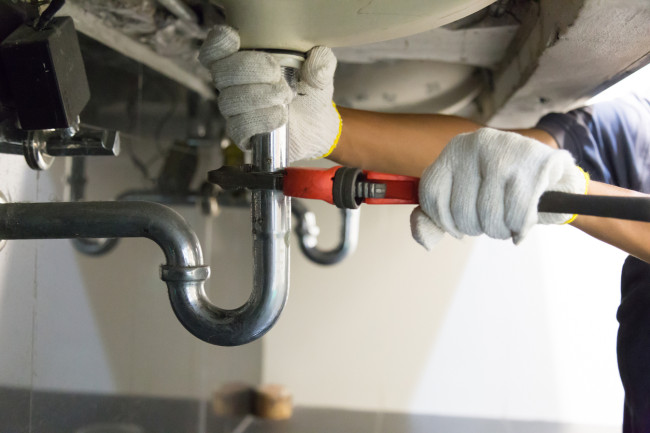5 of the most annoying apartment fixes New Yorkers ALWAYS put off (and how to solve them)

Throughout this week, you'll be hearing about ways to address various New York City apartment issues. But which chores do we dread the most? Even if you're the kind of DIY maven that relishes tackling a new project every weekend, not all home improvement tasks are created equal. Whether they're time consuming or just a logistical hassle, there are certain fixes that we always seem to find ourselves putting off week after week.
We spoke with the professionals to discover five of the most procrastination-prone NYC apartment headaches:
What's below you
"People really do put off repairs on their floors, because it's a nightmare," says Prime Renovations founder Jeff Streich.
Though the cost of cleaning, sanding, or finishing your floors isn't necessarily exorbitant, getting your stuff—and yourself—out of the way for the process tends to become an obstacle. "People don't want to deal with it, because you have to move out, or move all your furniture around," says Streich. "It's a mess."
For this reason, it really does pay to maintain a certain day-to-day level of upkeep—keeping clutter off the floors (organizing magazines, gadgets, etc. in baskets can help), and frequently sweeping and vacuuming. A little prevention now can often prevent the need for larger fixes down the road.
Hanging objects above you
Apparently, no one is too keen to climb up on a ladder, and awkwardly crane their neck while trying to nail in their artsy new chandelier. "Mounting anything on the ceiling is obviously more difficult, since gravity is working against you," says Big Apple Handyman owner Kamani Sicard.
Besides hanging plants, light fixtures, and the like, this can also come up as an unexpected issue if you've got floor-to-ceiling windows—and thus need to hang your curtain rods from the ceiling. "It's often corner apartments that have floor-to-ceiling windows, and that's also the part of the building that's built to be the most solid, often with reinforced concrete," says Sicard. "It's material that's purposely made not to break, so drilling into it gets tough."
This is one fix where it's wise to call in a professional, rather than take on the heavy-duty drilling yourself.
Getting (your doors) back on track
Whether it's the shower door, a closet, or even the entry to your bedroom, when it comes to sliding or rolling doors, it's easy to get used to living with with a slightly broken version of how it's really supposed to work. "Bi-fold or sliding doors can get caught up in the tracks, and then you have to lift the door up out of the track to get it to move," says Streich.
While the problem is as simple as replacing the track that the door moves along, this often ends up at the very bottom of the to-do list. (One Brick editor may or may not be putting off this very task for six months and counting.) "It's still functional, and you can use it like this—it's just a pain," adds Streich.
Assembling a gallery wall
Trendy though they may be, creating a gallery wall is a deceptively involved process, requiring careful planning and measurements. After all, before you start nailing things to your walls, you'll want to have an exact plan of how the whole thing goes together. (We've got tips on that process here.)
"With a gallery wall, each picture has to go in a different spot, and you have to know exactly where you want to put it," says Sicard. "And then you might look at it and decided you don't like it."
This can become a headache if you're directing someone else who's hanging the pictures ("No, actually, can you take out the nail and move everything just an inch or two to the left?"), and if you're taking on the task yourself. "A lot of people put them up themselves, then have 100 pictures up and realize after the fact that they're not in a straight line," says Sicard.
Of leaks, drips, and drains
From dripping faucets to clogged drains to problems with your water pressure or radiator, unsurprisingly, water-related issues tend to be the biggest source of headaches for apartment dwellers. "Ninety percent of the time with these, you need to call in a plumber, but whoever wants to deal with that," says Streich. (Though this is a situation where it pays to be a renter and simply call in the super.)
"There are the more obvious things like leaks, that people can see, but then there are water-related issues that aren't as visible, but could cause big problems," adds Bolster CEO Fraser Patterson. For instance, Patterson recommends freshening up the caulking in your bathtub and bathroom, as any cracks could lead to water seeping into the floors and causing serious issues.
Also in this category are perennial annoyances that are out of your hands—and that the building has to handle. Think clanging radiators (this is a building-wide problem with steam and pressure building up in the boiler system), and shoddy water pressure.
"Sometimes the building has a bad pump system that needs to be replaced, and sometimes the building has secretly put in a low-flow faucet to save on water, and then they'll claim, 'Oh, it's just like that!'" says Sicard.
If you can't simply replace the fixtures with a faster-flowing option, then it's time to start pesting your landlord for a larger fix. After all, you're allowed to procrastinate on home improvement, but the building's management? Not so much.
You Might Also Like
You Might Also Like



























